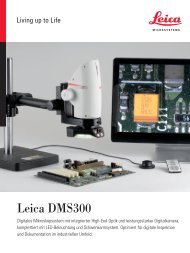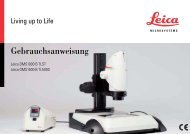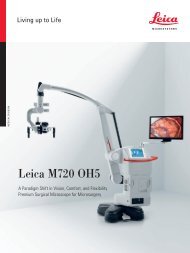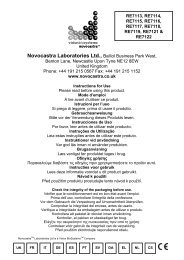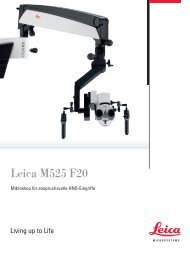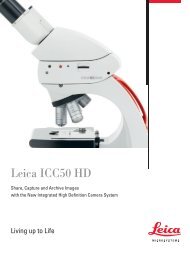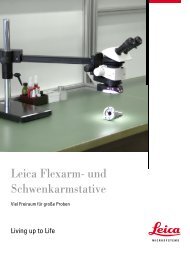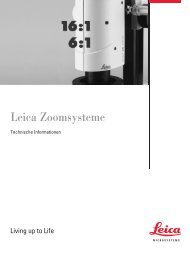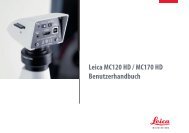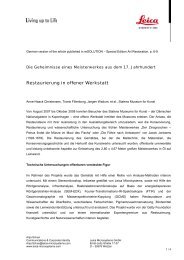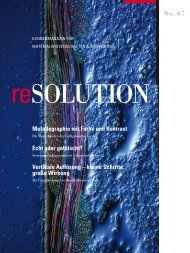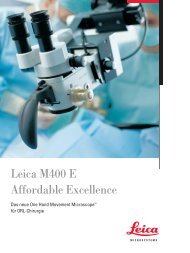The Theory of the Microscope - Leica Microsystems
The Theory of the Microscope - Leica Microsystems
The Theory of the Microscope - Leica Microsystems
You also want an ePaper? Increase the reach of your titles
YUMPU automatically turns print PDFs into web optimized ePapers that Google loves.
16<br />
16.0 Darkfield Illumination<br />
Two types <strong>of</strong> darkfield condensers are shown in Figure 19. <strong>The</strong>se produce an intense<br />
hollow cone <strong>of</strong> light with its apex (or focal point) in <strong>the</strong> plane <strong>of</strong> <strong>the</strong> specimen. If <strong>the</strong> specimen<br />
is completely transparent and homogeneous, <strong>the</strong> light continues directly on through<br />
and does not enter <strong>the</strong> objective, since <strong>the</strong> N.A. <strong>of</strong> <strong>the</strong> illuminating cone exceeds that <strong>of</strong><br />
<strong>the</strong> objective. <strong>The</strong> field <strong>of</strong> view will thus look dark. If, however, <strong>the</strong> specimen has fine<br />
transparent detail which differs in refractive index from <strong>the</strong> embedding medium, it will<br />
scatter light due to refraction and reflection, and will appear bright, since some <strong>of</strong> this<br />
scattered light will enter <strong>the</strong> objective. This type <strong>of</strong> illumination, known as “darkfield,” is<br />
useful principally on transparent unstained material where brightfield illumination fails to<br />
make <strong>the</strong> object visible due to <strong>the</strong> low contrast. Figure 20 is a photomicrograph <strong>of</strong> such a<br />
specimen taken in darkfield illumination.<br />
Darkfield condensers depend on <strong>the</strong> use <strong>of</strong> a high N.A. hollow cone <strong>of</strong> light, and must be<br />
oil-contacted to <strong>the</strong> lower face <strong>of</strong> <strong>the</strong> object slide in order to obtain <strong>the</strong> required N.A. in <strong>the</strong><br />
illuminated cone. It is also, <strong>of</strong> course, necessary to use an objective <strong>of</strong> N.A. somewhat<br />
under <strong>the</strong> illuminated N.A. <strong>of</strong> <strong>the</strong> darkfield condenser to avoid direct light getting into <strong>the</strong><br />
image.<br />
Objectives higher than 1.0 in N.A. must be provided with <strong>the</strong> appropriate “funnel stops” to<br />
reduce <strong>the</strong>ir N.A.’s to 1.0. <strong>The</strong> “funnel stop” is a small baffle which fits into <strong>the</strong> back <strong>of</strong> an<br />
objective, reducing <strong>the</strong> aperture at <strong>the</strong> rear lens surface. <strong>The</strong> effectiveness <strong>of</strong> a darkfield<br />
system is also dependent on <strong>the</strong> use <strong>of</strong> an intense, non-diffused, light beam from <strong>the</strong> lamp<br />
condenser. A homogeneous brilliant source, such as a ribbon filament or carbon arc, is<br />
required.<br />
OBJECTIVE<br />
OBJECT<br />
PARABOLOID<br />
CONDENSER<br />
OBJECTIVE<br />
OBJECT<br />
CARDIOD<br />
CONDENSER<br />
Figure 19 Two types <strong>of</strong> darkfield condensers. Each delivers a hollow intense cone <strong>of</strong> light, <strong>of</strong> greater N.A. than<br />
<strong>the</strong> objective N.A.,hence objects are seen only by virtue <strong>of</strong> <strong>the</strong> light which <strong>the</strong>y scatter.<br />
Figure 20 Emulsion <strong>of</strong> sulphonated oil in darkfield. Photomicrograph by<br />
G.G. Schneider.



